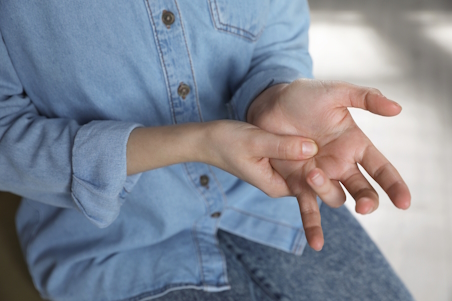Trigger finger Matimati keu
Trigger finger is when the tendons in your finger become locked after you bend it, making your finger difficult to straighten. Trigger finger usually develops in people aged over 40. It is more common in women than men. It can also affect your thumb.
Causes of trigger finger
We often do not know exactly what causes trigger finger. It involves one of your tendons, the strong tissue that attaches a muscle to a bone.
When you bend or straighten your finger, the tendon slides through a tunnel at the bottom of your finger, called a pulley. The pulley keeps the tendon in place.
Inflammation or irritation means part of the tendon swells (creating a nodule). It then cannot slide through the tunnel and catches instead.
Sometimes it happens after heavy use of your hand. For example, repetitive screwdriving or using tools that press on your palm, such as garden tools or secateurs. These may cause some inflammation.
It is more common if you have certain conditions, such as:
- rheumatoid arthritis
- amyloidosis
- diabetes
- carpal tunnel syndrome.
It can also be more likely to happen if you are on dialysis. But most people with trigger finger do not have any of these conditions.
Symptoms of trigger finger
If you have trigger finger, often you may:
- find it difficult to straighten your finger — you may need to pull it with the other hand
- hear a click when it is pulled straight
- feel pain when you move your finger
- feel a snap when your fingers are bent
- get a lump in the palm of your hand.

A person with trigger finger, causing the finger to be stuck in a bent position
There are different grades of trigger finger. A mild trigger finger may be painless. You might be able to straighten it just by paying attention to how it feels and hearing it catch.
If it is very severe, it can be sore and lock. You may not be able to straighten it, even using your other hand.
It is usually worse in the morning and gets better during the day.
Diagnosing trigger finger
Your healthcare provider will diagnose trigger finger by asking you questions and examining your hand. You might be asked about:
- other health conditions
- the type of work you do or hobbies you enjoy
- when you feel the triggering symptoms
- how long they have been happening for.
Treating trigger finger
Rest
You can often treat trigger finger by resting your hand for 4 to 6 weeks. This lets any inflammation clear and fixes the problem for most people.
You can also try:
- using a simple support that keeps your finger straight at night — you can get a resting splint from a hand therapist
- taking a simple painkiller like paracetamol or a non-steroidal anti-inflammatory drug such as ibuprofen.
Steroid injection
If rest does not work, your healthcare provider may inject your tendon sheath with anti-inflammatory medicines that reduce swelling (steroids).
Steroid injections for trigger finger work best if you have them within 3 months of first noticing any symptoms.
After your injection, you can use your hand for light activities while you slowly return to your usual activities. You should protect your finger for a few weeks by avoiding repetitive activities like:
- gripping
- grasping
- palm pressure
- vibration.
Hand therapist
You can see a hand therapist who can help with:
- exercises for your finger
- finger splints
- advice.
Some physiotherapists may also have experience with managing trigger finger.
If your trigger finger is related to the work you do, ACC may help with the cost of your treatment.
Surgery
Only a few people need surgery for trigger finger, as steroid injections are very effective. Surgery may be an option for you if you have had 2 steroid injections and still cannot straighten your finger. Your healthcare provider can refer you to a specialist.
Surgery aims to release the pulley so the tendon can glide more easily. It is done under a local anaesthetic injection that numbs the area while you are still awake.
Preventing trigger finger
To prevent trigger finger or reduce the chance of it coming back, there are things you can try.
- Use padded gloves if you regularly use tools that press against the palm of your hand or use tools with a soft-grip cover.
- Loosen your grip and avoid strong, repetitive gripping — change the pressure you put through your palm when holding things.
- Apply gentle pressure and massage using a circular motion around the base of your affected finger or thumb.
- Stretch your fingers out straight, using your other hand to gently stretch your fingers back.